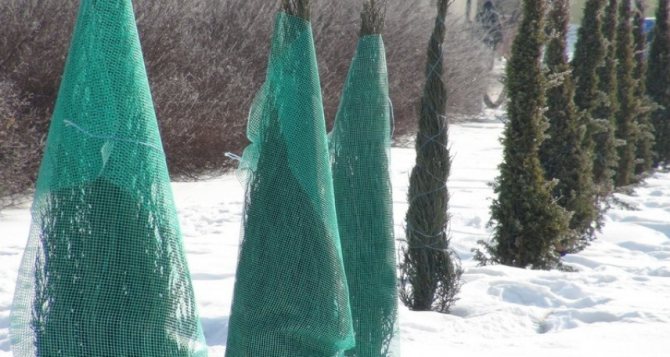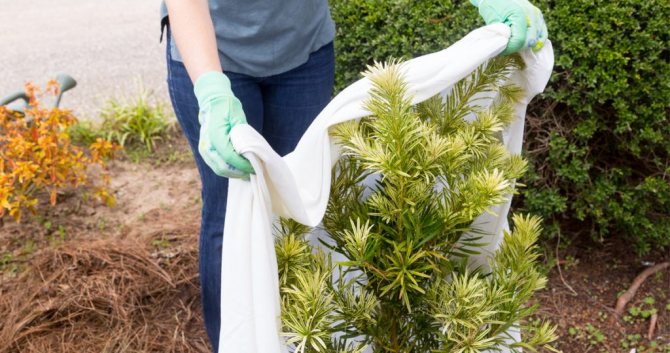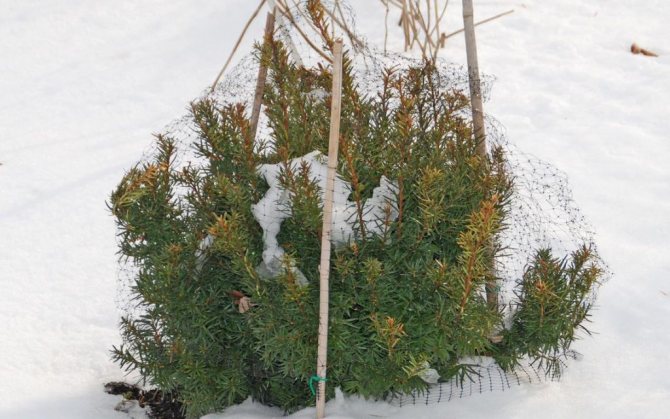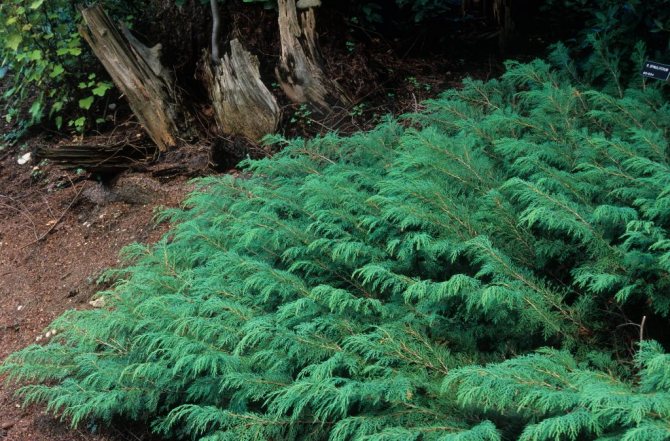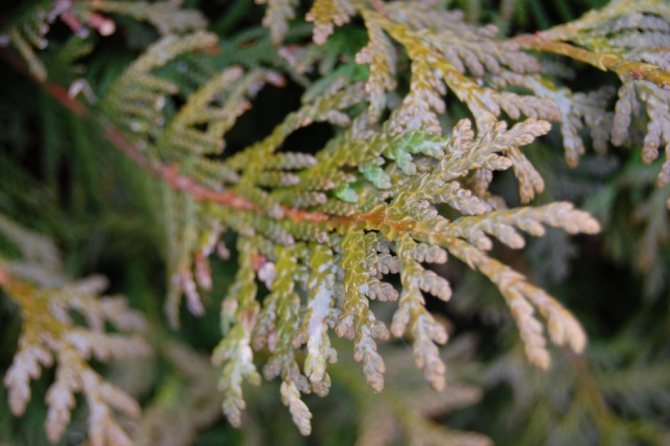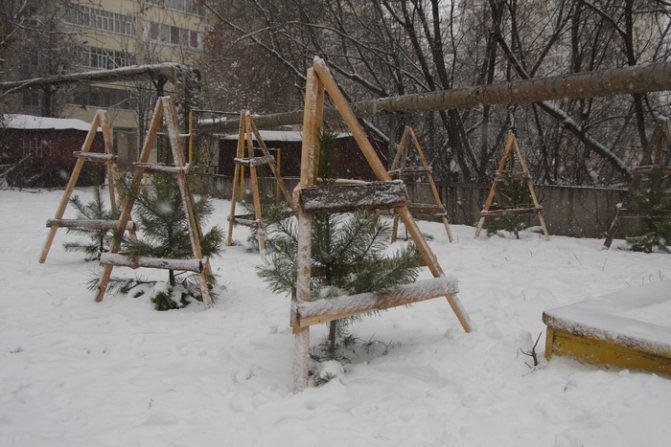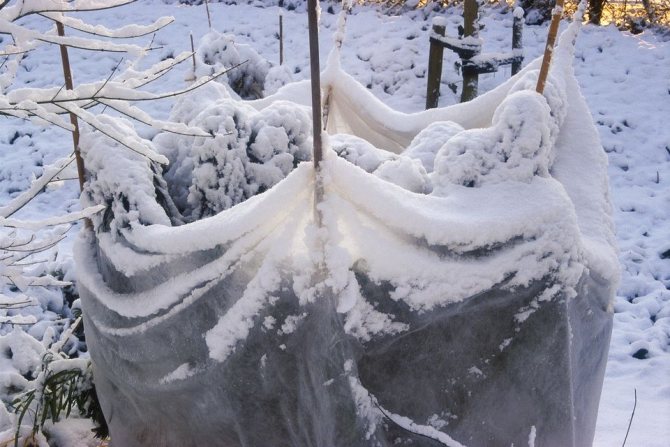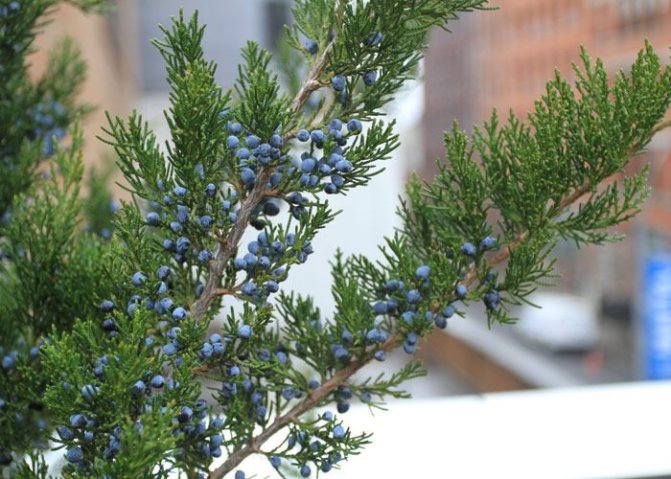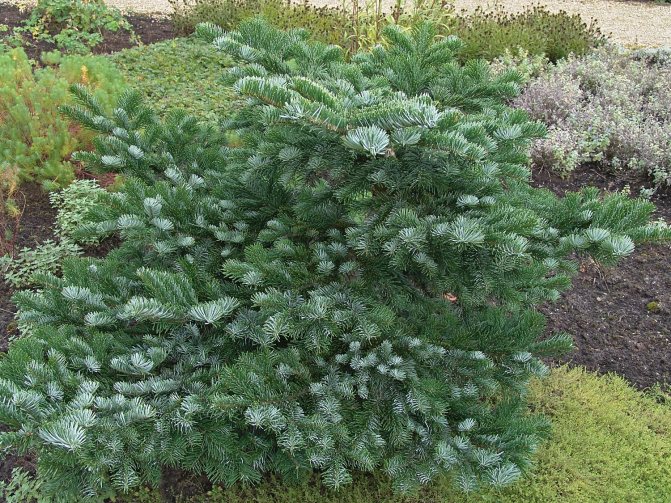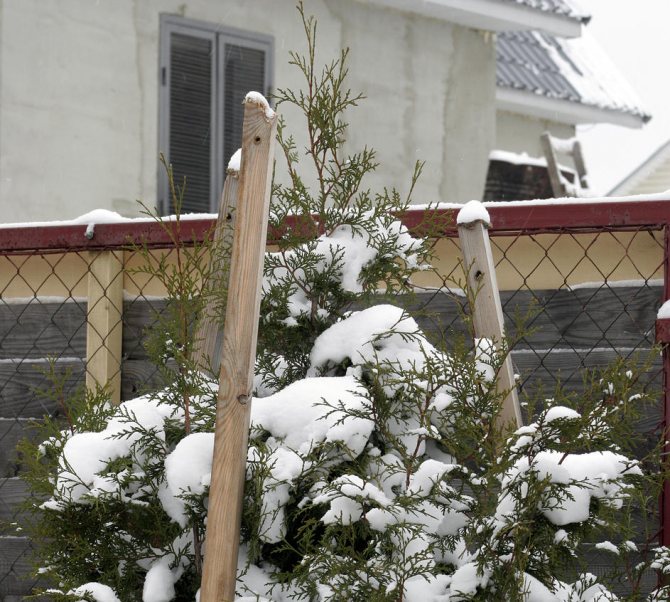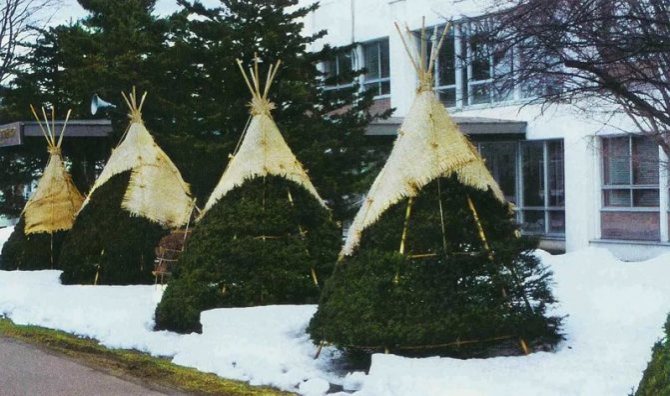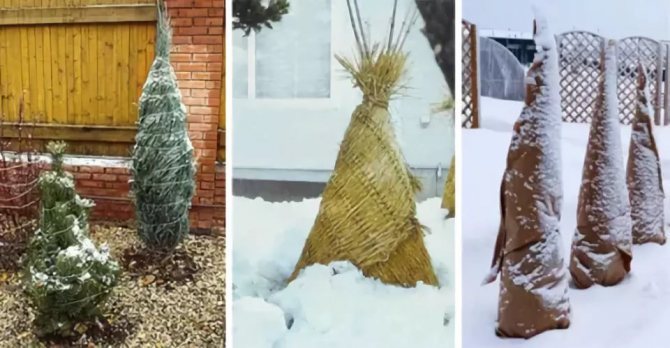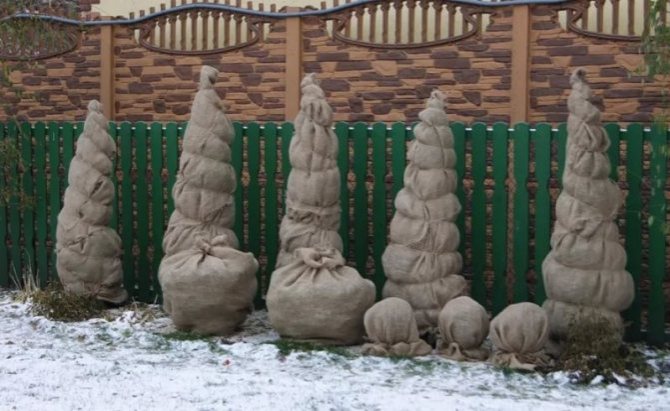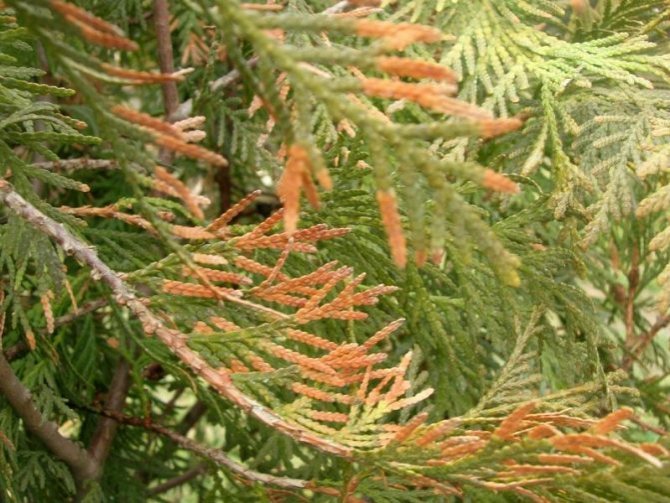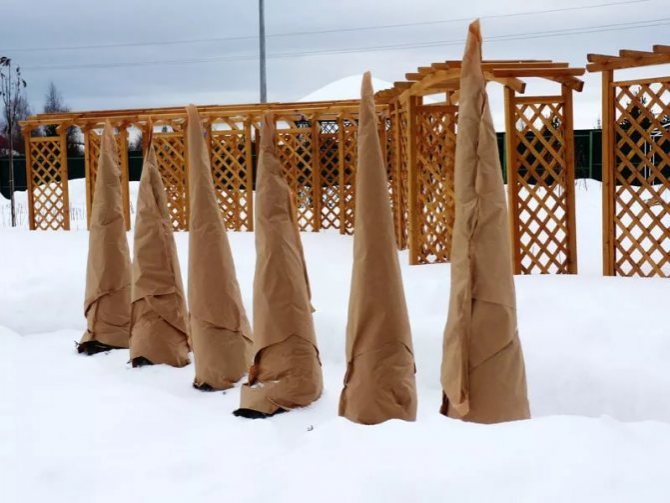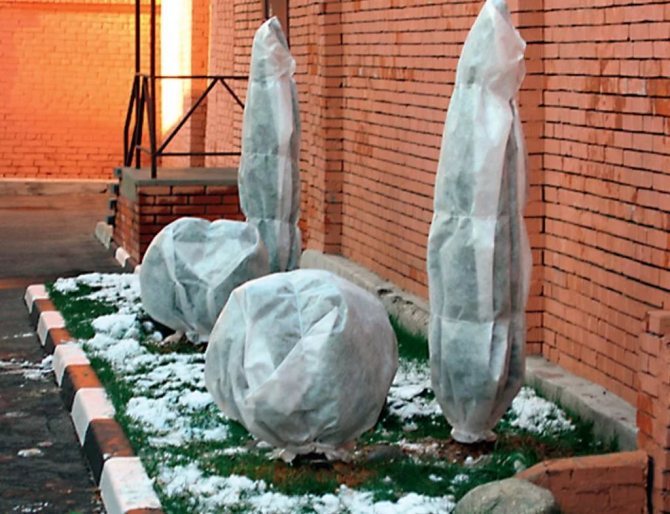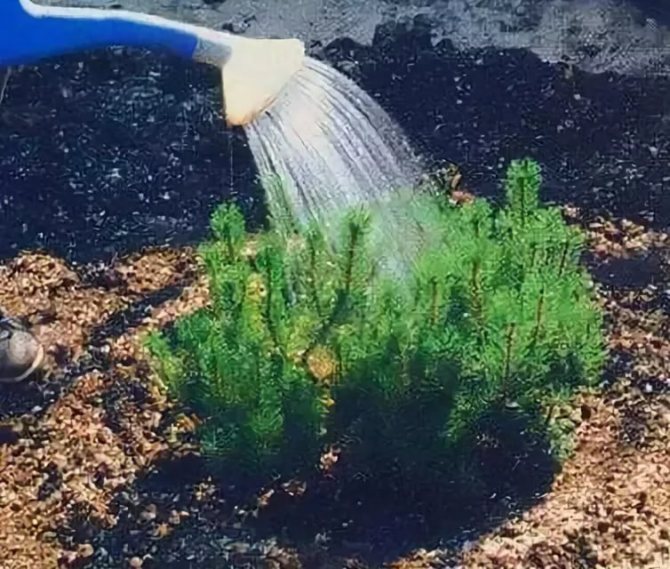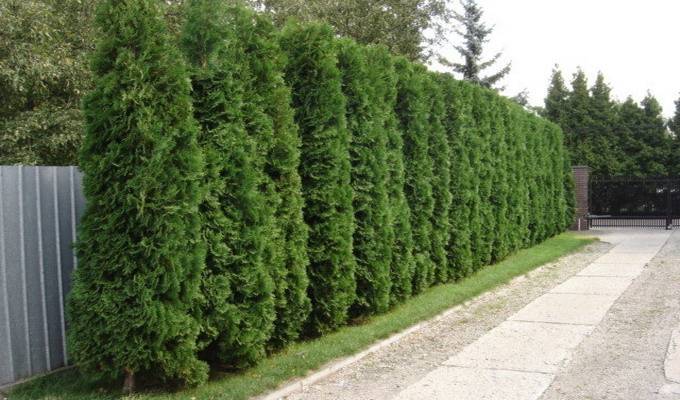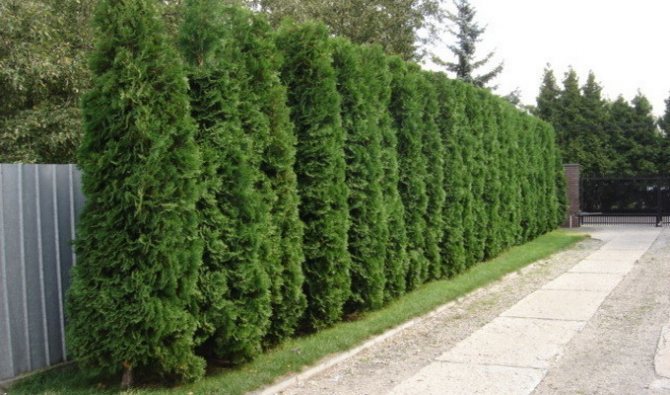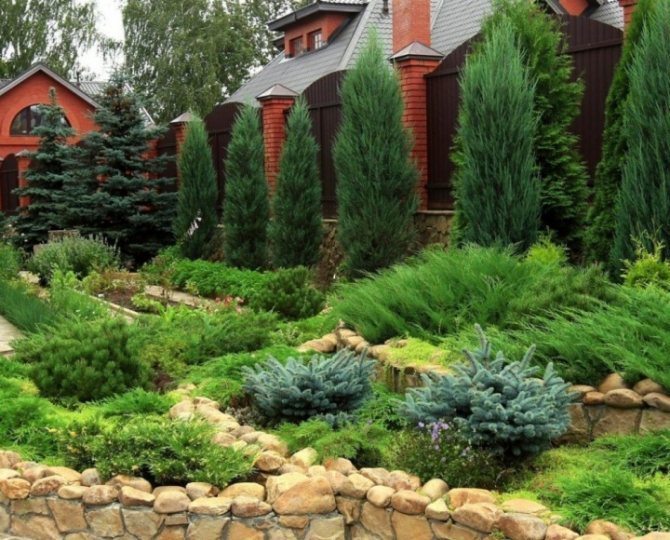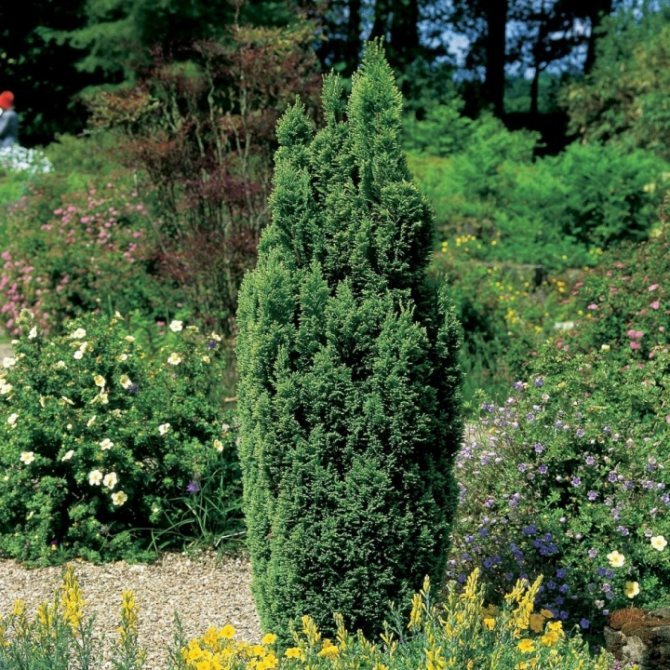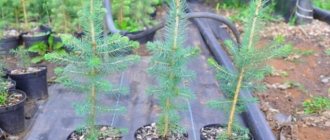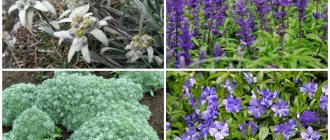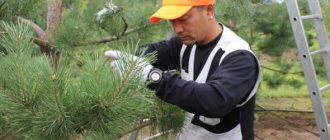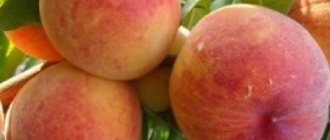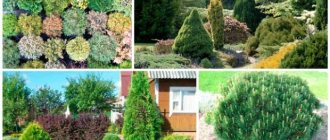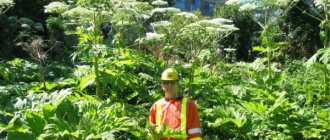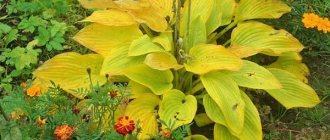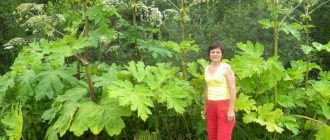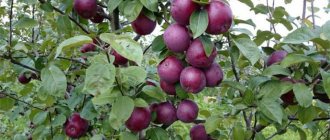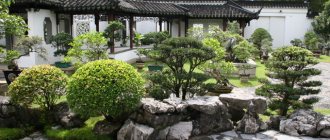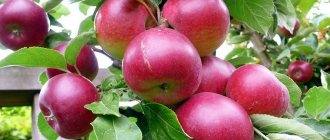23.11.2019
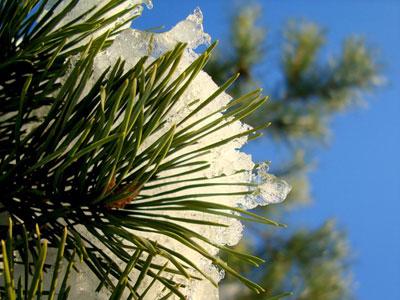
Coniferous plants delight us with rich shades of green all year round. But you need to remember that at first after planting, they need shading from the winter sun.
The first two years are especially critical, when the plant has not yet fully adapted to the new place. During this period, shading is a must.
Why harbor ephedra
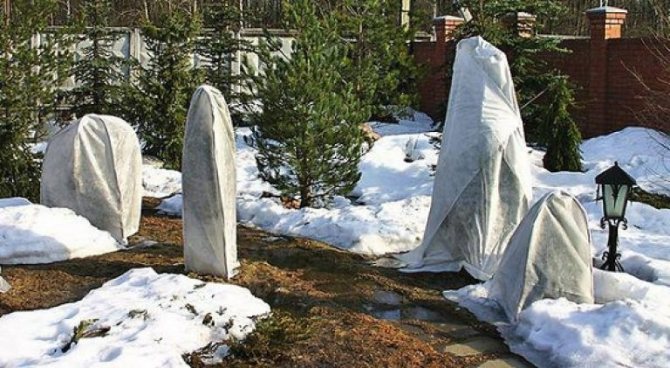

The most vulnerable in winter are young plantations, which are not yet 3 years old. Show the utmost care for them. They need to be covered for the following purposes:
Mature trees also need to be covered. With heavy rainfall under the weight of snow, branches can break. Conifers older than 3 years can withstand exposure to sunlight and gusts of cold wind, so there is no need to protect them.
Troubles in the winter months
If you took into account the previous tips, it means that in winter your pets will feel quite comfortable, but the care does not end there. Winter weather brings many surprises, and you need to fight them in time.
Surprise one: heavy snow
Heavy snowfalls sometimes occur in winter. Wet snow with a heavy load settles on the conifers, causing fractures of skeletal branches and breaking off thin ones. If your pet is covered with a sticky and wet snow cap, do not try to shake it off by tilting branches or shaking the trunk. During this time, the bark and branches are so fragile that you will cause cracking. You need to wrap the end of the board with a soft cloth and pry each branch of an adult tree with it, gently swinging it up and down. Shake off all branches in the access zone of your growth with a stiff brush or broom, leading from the tips to the trunk.
The crown of spherical and columnar varieties can be saved by tying it with twine. Just do not pinch the branches so as not to disturb the circulation of the juices. The twine should firmly press the crown against the trunk, but not squeeze.
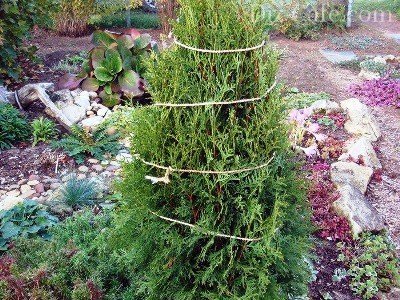

The crown tied with twine becomes compact and dense, not allowing snow to pass into the middle, which helps to survive the winter without breaking
Surprise two: freezing rain
With the contrast between day and night temperatures, tree branches can become covered with an ice crust. It has sufficient weight, tilting its legs and threatening the safety of the plant. You will not be able to shake off such beauty, since it firmly adheres to the needles. In this case, the props that you used in the summer to support the fruit trees will help out. Substitute them under any branches that are bent too low to keep them from breaking. It remains to wait for a sunny day for the ice to creep under the rays by itself.
The risk-free way
A shelter in the form of a wigwam, slightly larger than the covered plant, has proven itself well. The frame is made of bars or boards and burlap is pulled over it. This material protects the crown well from the sun and does not raise the temperature under the shelter, and the design itself protects the needles from contact with wet burlap.
The only drawback of this method is that inside the wigwam, due to the wetting of the burlap, a more humid environment is created, favorable for the development of pathogens. Therefore, it is necessary to cover the spruce not from the fall, but precisely during the season of the alleged burning.But it is better to install the frame earlier, while the soil is not frozen yet.
Pruning and shaping the crown of a blue spruce
Blue spruces do not need systematic pruning, since the crown of the tree is formed on its own. But it is worth paying attention to the plant at least several times a year, since diseased and broken branches, dry and yellowed ones, which negatively affect development and decorativeness, should be removed from the trunk!
Also, if there is a desire to independently form the crown and control the growth of the spruce, you can do this, but preferably until the age of 7-8 years. After that, it is better to leave the blue spruce alone and let it develop further completely on its own.
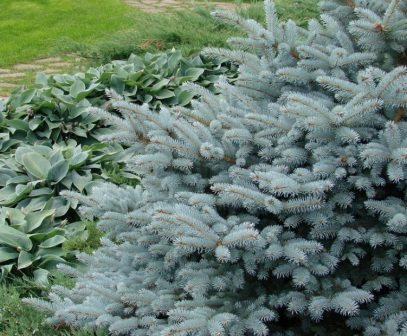

You can always form the crown of the spruce, but it is better to let it develop on its own
How to cover
Cover spruces, pines, fir and other conifers with spruce branches, burlap, or white spanbond. The work to protect trees can be done independently, it consists of several stages:
- Pour a thin layer of sawdust, peat or spruce branches near the root trunk. For this purpose, you can use spruce or pine needles.
- Gently press the branches against the trunk and tie them with a thick, tight rope. You do not need to tighten it too much.
- Create a frame with stakes or metal rods. Do this carefully so that it does not touch the branches. A great alternative is to use a plastic mesh. It is flexible, so it is easy to create a frame of any size and shape with it.
- Cover the plant with pre-prepared material. Experienced gardeners recommend using spunbond or agrofiber for this purpose. First, it has good thermal insulation properties. Secondly, it perfectly permeates air and steam, which avoids fogging. Fasten the material together with a stapler.
As spring approaches, create an additional barrier over the young conifers to prevent evergreen trees from being exposed to sunlight. After the frost has receded, periodically remove the shelter to provide ventilation.
Stunted conifers
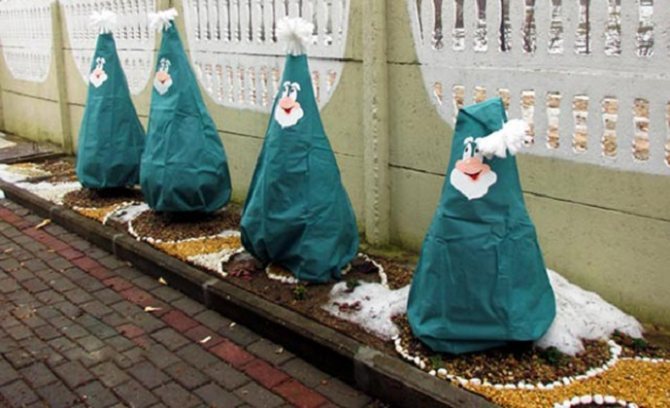

The easiest way to keep a plant of a small height in winter is to nail a rail near it and hang a flower pot or a small bucket on it. Carefully put the covering material over such a frame and connect it with a stapler. Such a measure to prevent the crown of the ephedra from sagging from heavy rainfall, the pot or bucket will perform a protective function.
If there is no special covering material, you can protect small conifers with spruce bast shoes. Gather them around a cone-shaped tree and tie it with twine. If your crop has a weak and unstable root system, cover the area around the base of the trunk with additional mulch.
Medium shrubs
For medium sized conifers, create a wooden frame. Gather the rods into a cone shape and secure them together with staples. Place the covering material on top of the frame and secure it with a stapler. It is important that it does not fit snugly against the tree, as the needles can crumble, and fragile branches can break.
Do-it-yourself work - tips for beginners
If one-year-old seedlings have already been planted in open ground by the fall, then here it is necessary to approach the shelter of plants for the winter somewhat differently. First, the root system should be insulated. To do this, you can pour a large layer of sawdust or peat on top of the soil in the area of the trunk circle. Also, for these purposes, the spruce spruce branches indicated above, laid directly on the ground or just coniferous needles, are suitable for these purposes.
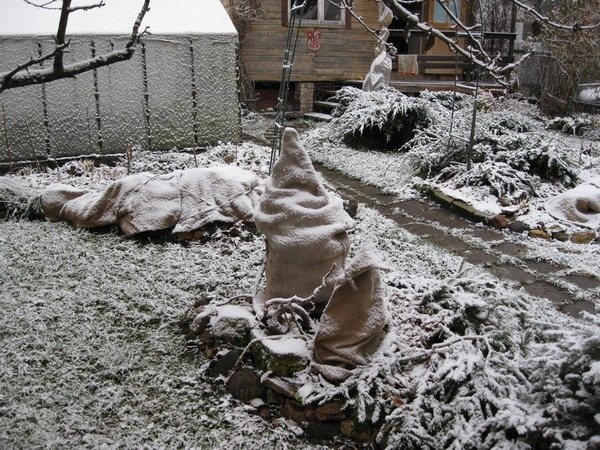

The branches should be tied with twine so that they are pressed against the trunk. Firstly, then it will be much easier to wrap the plant with heat-insulating material, and secondly, this will protect the branches from wind and heavy snow.
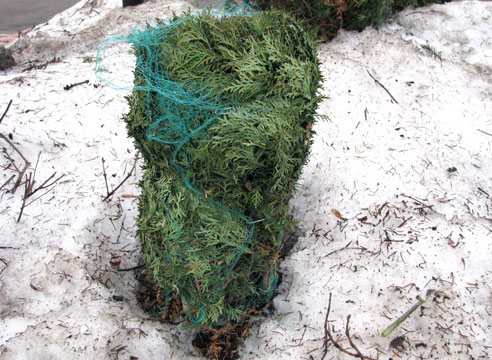

To shelter conifers, you can use a material known as spunbond or agrofiber. It is a special non-woven fabric with a high degree of resistance to both low and high air temperatures. He is not afraid of precipitation - rainfall, wind, snow and even hail. A definite plus - it allows air and steam to pass through, so that the covered plants will not suffer from rotting.
How to cover conifers for the winter
Sheltering conifers for the winter is a very responsible process of plant protection, so we recommend that you study the video and other information provided in this article. Already in the fall, when the days are either sunny or rainy, it is necessary to take care of young seedlings. Conifers during this period are not yet sufficiently strong, which means they can be severely affected by strong winds or the first frosts. It is the first wintering that is quite dangerous for these plants. There are several ways to hide.
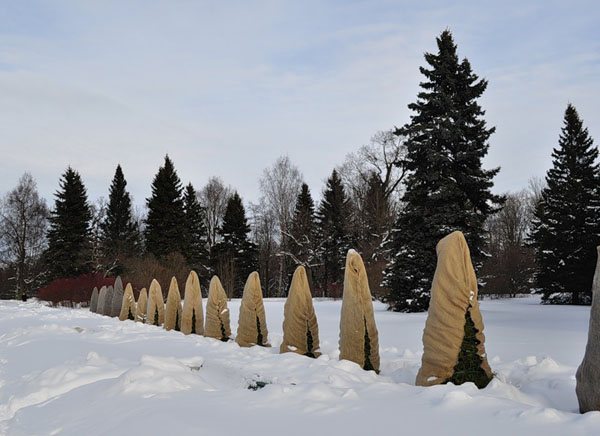

So, if your coniferous tree grows in a tub, then you should definitely bring it into a house or a room where a constant temperature is maintained. However, the size of the plants can change your plans - if the trees simply do not enter the doors, you will have to think about hiding coniferous beauties right on the street.
As an effective and inexpensive covering material, you can use spruce branches, which are laid in the form of a hut, covering the plant from top to bottom. By the way, this affordable heat-insulating material can be used to protect against winter frosts and other plants.
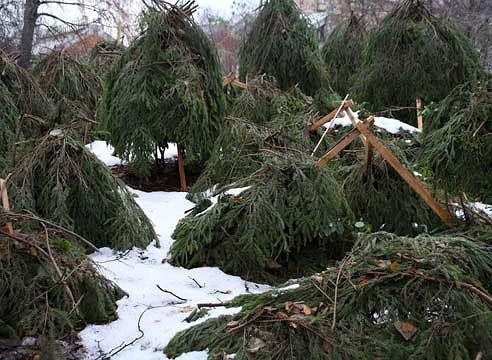

What if you can't get spruce branches? Then you can make a covering material in the form of homemade pillows stuffed with sawdust, straw or various rags. If the frosts in your area are very strong, we advise you to use everything in the complex for plant protection - both spruce branches and bags. All of your multi-layer protection should be well reinforced so that nothing will fly apart in strong winds. To do this, spruce branches are fixed with staples or simply sprinkled with earth below, and the pillows are tied with twine.
Features of shelters for different types of plants and regions
Protection for conifers is created in various ways, depending on the type, size and winter hardiness of the plant:
- for tall columnar specimens, a cone-shaped frame is usually built, insulation is laid on top, which is fixed to the support with ropes or garden staples;
- to cover a tree with a spreading crown, the branches are neatly tied with twine, and if this is not possible (the crown is located horizontally), a canopy is built to protect the branches from heavy snowfall and icing;
- undersized and creeping decorative species (junipers, miniature pines, barberry) are covered with spruce branches or dry foliage, bending the branches to the ground.
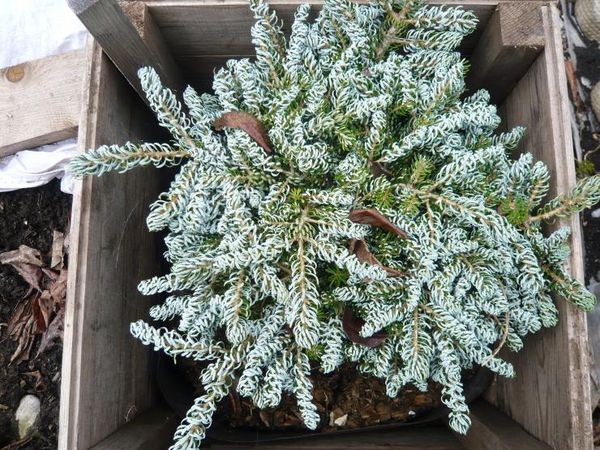

When constructing a shelter, the climate of the area must also be taken into account. So, in the northern regions, where winter is frosty and long, in addition to surface protection, it is necessary to increase the layer of mulch, and fill the inner space of the frame with hay or foliage.
For southern and temperate latitudes, another problem is relevant: already in February, the number of sunny days increases, the crown begins to heat up and burns appear on it. To prevent this from happening, the crown must be shaded by installing a protective mesh or burlap screen on the side from which the sun falls.
When to cover different types of trees
The best time to create a protective cage for plants is the second half of October - the first half of November. It is important that the weather is dry outside, accompanied by the onset of stable cold weather. Only young plants need shelter. Their age for protection depends on the type of plant culture:
| Ephedra type | Age to hide |
| Spruce or pine | up to 1 year |
| Fir | |
| Juniper | up to 3-4 years |
| Thuja | up to 3 years |
| Yew | up to 1.5-2 years |
There is no need to cover mature trees in central Russia.They are already strong enough to withstand the effects of frost, gusts of wind and sunlight. The only thing that needs to be done is to periodically monitor the condition of the branches and clear them of snow.
Shelter timing
For conifers, cold is preferable to overheating, so you should not rush to cover. If the trunk circle is well insulated, the plants will withstand even severe frosts for several days. It is recommended to cover trees and shrubs thoroughly only after the onset of stable cold weather, when the night temperature drops to -5 ... -7 ° C. The daytime temperature should be taken into account. If the weather is sunny, condensation will accumulate under the insulation, so it is better to wait for a while or cover the plants only at night.
Rules for preparing plants for wintering
Autumn water charging irrigation
Despite the subzero temperatures, life processes in coniferous crops do not stop, but only slow down their course. Therefore, trees and shrubs must be prepared for winter, taking this circumstance into account.
Before the onset of the first frosts (around the end of November), spend the last abundant watering of the conifers. Pour 2 buckets of water under each crop up to a meter, and 3 to 5 buckets above a meter. Thus, you will provide the plants with a supply of moisture for the pre-spring period. At the end of February, when the sun begins to bake, the crown of conifers comes to life and requires nutrition and moisture from the roots. And if it is not enough in the soil, then the frost fetters the earth to a great depth. The roots cannot take water, so the needles become dry and are easily burned by the scorching rays.
Watering is especially necessary:
- one-year and two-year-old seedlings that have not developed a strong root system;
- rare breeds of conifers with poor winter hardiness;
- plants, the crown of which was formed and sheared this season.
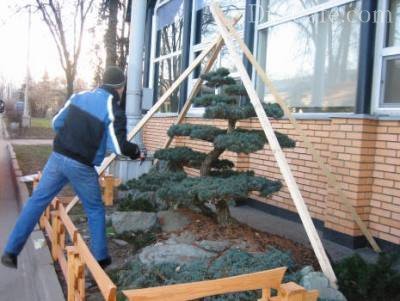

If there are conifers on the site, grown using the bonsai technique or with a topiary shearing, they need a solid shelter from the snow
Phosphate-potassium supplements
In order for the young branches of conifers to mature by the beginning of winter, you need to properly feed the plants. Already from August, exclude all fertilizers that contain nitrogen. It provokes a rapid growth of green mass, and this will greatly weaken the immune system. It is useful to add a mixture of potassium and phosphorus to the soil in September. Thus, you will speed up the lignification of the branches and strengthen the root system.
Mulching young plants
Mulching is a prerequisite for healthy wintering for rare and non-resistant coniferous varieties. The ideal mulch is tree bark. It is large, makes it possible for oxygen to flow to the roots and, when the temperature rises, does not prevent the release of excess vapors from the ground. With this kind of mulching, the plants will never dry out, as is the case with sawdust.
Adult conifers or those purchased from a local nursery do not need to be sprinkled with mulch. They will cope with the winter without shelter.
Recent Entries
You will lick your fingers: 5 of the most delicious fish salads for the New Year 2020
How to prepare your garden for the winter cold:
When is the cover removed?
Taking cover requires great care and several conditions. Firstly, it is necessary that the ground thaws no less than the depth of the bayonet and the root system of the plant begins to work. This happens around the end of April.
Secondly, the shelter is removed in cloudy weather, so that a sharp change in illumination and direct rays does not shock the needles. Ideal if you have studied the weather forecast in advance and opened the plants on the eve of an overcast period of 4-7 days. Then your conifers will be able to gradually adapt to the light regime and painlessly switch from hibernation to growth.
Useful nursery links: Winter services for sheltering and planting conifers Covering material Preparing the garden for cold weather
How to check the winter hardiness of conifers?
You can reduce the likelihood of winter troubles to zero already at the stage of buying seedlings. If you buy thuja, spruce, junipers in domestic nurseries, where they grew for several years in the same climatic conditions as in your area, then the problems with winter hardiness will disappear. Weak crops freeze out already in the first year after planting in the nursery, so they simply do not reach the shelves.
But more often we purchase planting material on the market, where it is impossible to check whether the seller gave the exact information about the growing conditions of the seedlings. And even if all the plants were grown in the local climate, there is no guarantee that they were not overfed with nitrogen fertilizers to accelerate growth. An excess of nitrogen significantly reduces the immunity of crops and leads to freezing.
How to grow a spruce, read here:
Therefore, the owners themselves must take care of the conifers, preparing them for hibernation at the end of autumn.
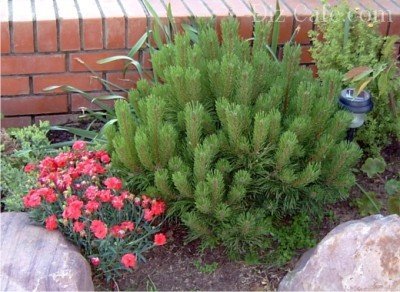

In small areas, different types of dwarf pine get along well, which stands out for its winter hardiness and ability to withstand snow loads
Among the crops that are more damaged than others in winter, the leading ones are tueviks, fir (except for Siberian and Vici), metasequoi, cypresses and cypress trees. In areas with a harsh climate, it is better not to plant these crops or tune in to the fact that every winter they will have to be protected from frost.
The list of the most unpretentious conifers includes:
- Ate (except for East and Brever);
- Cedars;
- Larch (except Western);
- Pines (except Thunberg);
- Junipers (except for Turkestan and Zeravshan);
- Tsugi;
- Western thuja.
The rest of the varieties need to be selected taking into account the length and severity of your winters.
An overview of the best varieties of ornamental shrubs for arranging a garden here: https://enn.imadeself.com/ozelenenie/dekorativnye-kustarniki-dlya-sada.html
How to shelter conifers from the sun. Reanimating conifers after sunburn
It is known that problems with conifers begin from the first days of spring. And above all, these are sunburns. It often happens that there is little snow at the beginning of winter, and the soil under the plants freezes deeply with the arrival of frost. And then, after snowfalls, there is a dazzling white snow cover. Then, already in January-February, in frosty sunny weather, sunburns appear.
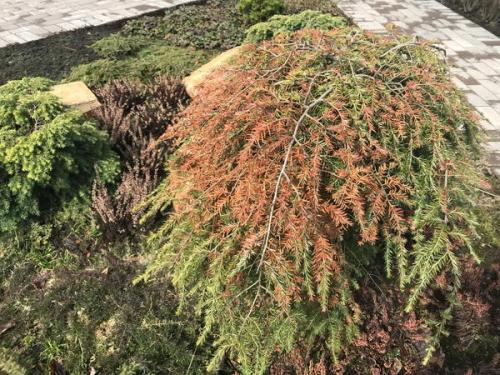

Sunburn on conifers is a common problem. Needles in the cold and the sun loses moisture, and the plant cannot replenish it at the expense of the roots - the root system is frozen. By spring, the trees are already with red needles, especially on the south side. Conifers are most affected in the first year after planting - they have not yet had time to develop the root system. Some species and varieties of conifers have low frost resistance, so sunburn is inevitable. To plant such plants, you need to choose the most protected places, in the fall, sprinkle the near-trunk circle with peat or shavings in order to prevent the root system from freezing. In the first year after planting, the crowns should be shaded with a facade mesh or covering non-woven material. However, such measures do not always save from sunburn. Then the question arises about the resuscitation of conifers. And here an important role is played by early spring watering and the use of growth regulators. If no more than 35-40% of the crown has suffered, then use it to resuscitate conifers from sunburn.
In the nursery of the POISK agricultural holding, we use the following scheme
- When the soil thaws and its temperature rises to + 6 ... + 8 degrees at a depth of 20-30 cm, we spray the crowns with Epin-Extra solution (2 ml / 10 l).
- After 10 days, when the temperature of the soil and air rises, we spray the crown with a solution of Zircon (1 ml / 10 L) and thoroughly shed the root layer of soil with the same solution - to activate the growth and work of the roots. You can also use the drug Kornevin at this time.
- Zircon treatment after using Epin-Extra can be repeated 2 or 3 times with an interval of 5-7 days, then spray the crowns of conifers with Epin-Extra again.
Thus, the resuscitation of coniferous crops from burns includes at least 4-5 treatments in April-May. If necessary, the number of sprays is increased. Of course, all this time you need to water the plants regularly to keep the soil moist.
What is interesting about a dwarf spruce?
Konica is a form of Canadian spruce that originated from a natural mutation in nature. This species was discovered in Canada at the beginning of the 20th century, from where it spread to Europe and became the main decoration of household plots. In gardening, there are other names for this species:
- Spruce Glauka Konika is a long-liver among trees. It can grow in one place for up to 300, and sometimes up to 500 years. Differs in soft, pleasant to the touch needles.
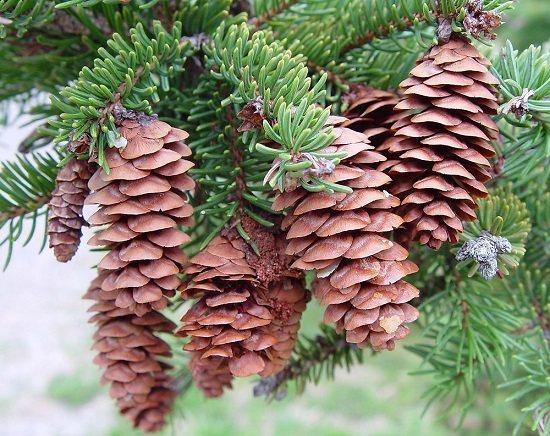

From the above description, without looking at the photo, we can conclude that the listed conifers have an unusual color of needles and a presentable crown.
Miniature Konica reaches a maximum height of 2.5 m.On average, the herringbone grows by 1 m.The diameter of the tree can reach 2 m, but usually it takes no more than 80 cm.The crown is formed perfectly evenly, which means that the gardener does not have to prune every year. The tree has a narrow, elongated shape that resembles a cone. The height and decorativeness of the crown are the main properties for which it is valued.
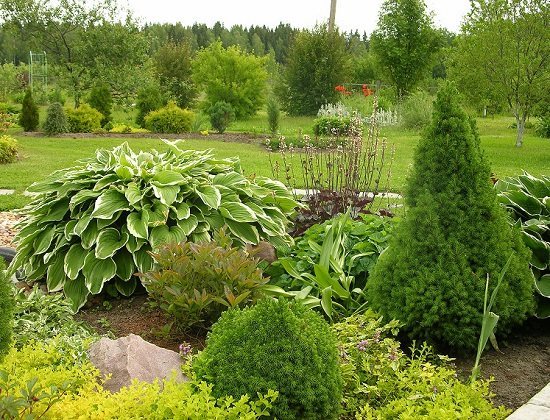

Ephedra is slow growing, especially at the beginning of cultivation. In the first 10 years, it grows by a maximum of 6-10 cm per year. Further, the growth proceeds even more slowly: the tree adds 1.5-3 cm in height annually. Cones rarely appear on the tree. They have a regular elongated cone shape, their length is 6 cm.
Konica does not tolerate polluted air. In an unfavorable atmosphere, it can wither away, therefore, it is rarely grown in urban areas.
There are a number of reasons why you should choose a Canadian coniferous baby for landscaping:
- There will always be a beautiful design on the site, while the gardener will not need to make much effort.
- A coniferous plant releases aromatic substances of phytoncides into the air, which cleanse it and get rid of harmful microorganisms.
- The plant is resistant to diseases.
- The needles have an unusual green-gray shade, and their length reaches 1 cm.
- The root system is superficial, which means that the plant can be easily transplanted if necessary.
- It propagates well both by cuttings and seeds.
Video with the recommendations of an experienced summer resident.
Landscaping Ideas: Combine With Other Plants
Conifers fit into almost any landscape composition, Canadian spruce is no exception from the list. It looks good in an ensemble with other conifers - thuja, pine, juniper, the varieties of which are so diverse. Neighborhood with deciduous, cereals is also considered successful. The discreet shade of the needles favorably emphasizes flowering shrubs.
Fir trees of this type grow well in a group, from which you can create a hedge. The branches are dense, densely covered with needles, ideal for building a good curtain from nosy neighbors. Placement near a playground, a gazebo is considered beautiful. She not only decorates the site, but also purifies the air around. The tree can be used to create compositions on a rocky area. Even if you plant one tree on the lawn, it will decorate the territory with dignity.
The shape of the crown of conifers (pine, larch, spruce, etc.)
Below is a table that describes the crown shape of conifers, including the crown shape for spruce, crown shape for larch, crown shape for pine, juniper, yew, microbiota and cypress.
Table "Crown shape of conifers":
| Coniferous plants | Characteristic |
| Norway spruce | Pyramidal crown, height up to 30 m, there are many forms of common spruce, they have different heights, shapes and shades of the crown |
| Spruce prickly blue | Narrow pyramidal crown, height up to 20m, various shapes exist |
| Spruce nesting | One of the forms of common spruce, spread-drooping crown, height up to 1.5 m, diameter - up to 3 m |
| Konik spruce | Narrow conical crown, dense, height up to 2 m |
| Scots pine | Oval-conical crown, height 20-30 m, needles with a gray tint |
| Pine black | Sprawling crown, height up to 40 m, dark green needles |
| Weymouth Pine | Columnar crown, branches start low from the ground, up to 40 m tall, needles are soft, bluish-green, 5 needles in a bunch |
| Mountain pine | Fan shaped crown, there are also multi-stemmed shrub forms, height no more than 4 m |
| Thuja western | Pyramidal crown, height up to 12m, there are many forms of different heights, types of crown and different shades of the color of the needles: bluish, variegated, golden |
| Thuja spherical | One of the western thuja forms, spherical crown, height up to 2.5 m |
| Common juniper | Conical crown, height up to 5 m.There are a large number of different shapes that differ greatly in appearance from the original |
| Red cedar | Retracted, mute egg-shaped crown, height up to 30 m, bluish-green needles, there are many forms |
| Juniper horizontal | Open crown, height up to 0.5 m, diameter up to 1.6 m, silver-blue needles |
| Juniper Cossack | Semi-spread crown, in contrast to juniper, horizontal branches are directed slightly upward, height up to 1.5 m, diameter up to 3 m |
| Pea cypress | Pyramidal crown, height up to 30 m Creates a "southern" flavor, other forms are unstable in our climate. Requires shadow |
| Larch | Cone-shaped crown, height up to 40 m |
| Yew berry | Ovate-cylindrical crown, height up to 5 m, diameter up to 5 m |
| Cross-pair microbiota | Spreading crown, height up to 1 m, diameter up to 2 m, does not tolerate transplanting well, adult plants cannot be transplanted |
When choosing conifers for your garden, first of all, you need to pay attention to the appearance, height, crown shape, appearance and shade of needles. What kind of crown different conifers have, you can see in the table.
conclusions
Thuja care in the autumn and preparation for winter is not difficult. In order for an evergreen tree to please its owner for many years and after a harsh winter it does not lose its decorative appearance, it needs to be watered well, trees in pots can be fed, pruned, mulched and carefully covered for the winter.
In our garden center you can choose different types of thuja. Experienced consultants will provide the necessary information for the care of this beautiful plant. Contact us!
Preparing blue spruces for winter
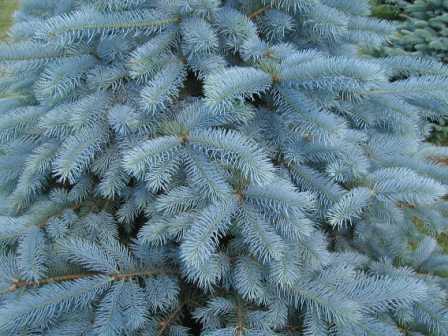

Proper care of the blue spruce will help you grow a beautiful decorative tree in your country house. Blue spruces are real queens of landscape design. These pretty trees look great in any part of the summer cottage, both at the entrance and on the outskirts. But in order to grow them really beautiful and decorative, it is necessary to provide quality care for blue spruces.
I have already talked about how to grow blue spruce from seeds. This lesson is painstaking, but very interesting, because the result speaks for itself. But in order to get really ornamental trees in a few years, to plant spruces and wait for their shoots to sprout, it is not enough, it is important to study agricultural technology and learn how to properly care for blue spruces.
Today we will tell you how to provide the best conditions and what needs to be done so that the trees in the country house are a real decoration, and not a semblance of an ordinary growth.
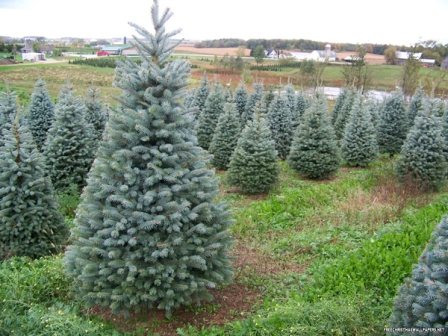

Follow the advice of a specialist, and blue spruce trees on the site will become a real decoration of the landscape.
Cypress pest and disease control methods
Proper care of the cypress tree does not cause any diseases, but the plant is still susceptible to the invasion of pests - scale insects and spider mites. Both parasites feed on the sap of the needles, which causes yellowing and loss of leafy parts.
When a tick appears on the branches of coniferous trees, a white web appears. It is impossible to see the insect itself, as it bites into the leaves of the cypress. Spraying with Apollo, Neoron and Nissoran preparations will help to overcome this misfortune. The procedure should be carried out repeatedly until the complete disappearance of the parasite.
The presence of the scale insect is noticeable. Look at the photo: this insect looks like light brown plaques on the shoots. You will have to get rid of it with several sprays of Aktar, Nuprid, Bi-58 new.
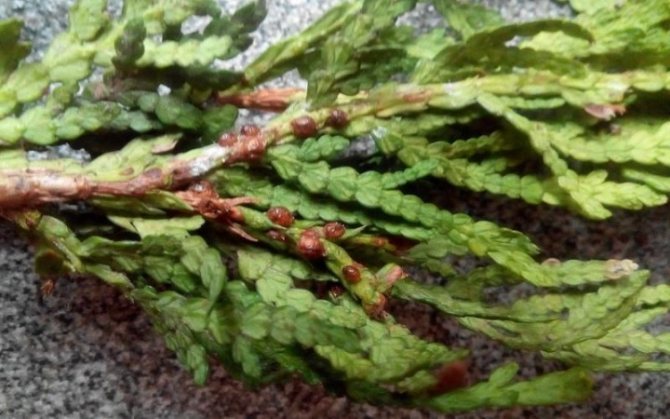

But problems also arise with improper care. Stagnant irrigation water in the planting pit, the lack of a drainage layer, and the proximity of groundwater threaten the root system and cause root rot. This fungal disease destroys the cypress so that it is not possible to save the tree. If the disease is detected on time, the plant must be dug up, the affected roots must be removed, and the healthy areas must be treated with a fungicide. In this case, pour boiling water over the landing site and treat with a special chemical. The treated tree should be planted in a new place, following the planting rules. A diseased specimen with completely rotten roots should be destroyed.
If parasites have settled on one coniferous tree, then they will inevitably appear on neighboring conifers. A timely noticed infection and taking measures to remove it will save the garden from unpleasant consequences.
Protection for low-growing shrubs
If your juniper or cedar is too young, or you are a fan of low-growing crops, then the amount of insulation work is significantly reduced. It is enough to stock up on spruce branches in the forest and cover the seedlings with it in the form of cone-shaped houses. Thrifty owners prefer to install plastic containers on top of the spruce branches for reliable fixation and maintenance of the temperature regime.
The industrial business satisfies any demand and therefore the Moscow Region is provided with a covering material for planting in full. It is sold in the form of cone-shaped bags with a pulling rope from the bottom. To prevent the ends of coniferous paws from turning yellow, it is enough to use special bags.
Agronomist's advice! "For young conifers with a weak root system, it is necessary to sprinkle sawdust or mulch at the roots before sheltering for the winter."
Spruce Konik on the site
As soon as it got warmer, I transplanted Konika to a plot closer to the entrance to the house. She was so small and defenseless that at first she needed our constant attention. We studied scientific and popular science literature with interest, trying to understand the features of this unusual spruce. It turns out that a dwarf tree with a silhouette similar to a sail is a long-liver, retaining such best qualities of Canadian gray spruce as frost resistance and resistance to strong winds. You can plant Konika in a sunny place and in shade. In May and early summer, Konica is especially good. It is at this time that young shoots grow, and the emerald needles seem very soft and fluffy.
Additional care
Despite the winter hardiness and unpretentiousness of the culture, mineral feeding will not hurt. Especially for freshly planted crops in the fall, so that they can take root until spring. The plant must be strong and disease resistant. How to feed pets on the eve of cold weather?
Let's describe a few steps leading to successful acclimatization and overwintering:
- in the fall we water 50-60 cm deep not only near the root, but also in the radius of the root system. In case of heavy autumn rains, the procedure is canceled;
- near-trunk mulching with organic matter (needles, pine bark, sawdust, spruce branches, hay, etc.) is poured into 1-2 layers, not thicker, so that rodents do not make a nest;
- feeding with vermicompost and compost will support the vitality of conifers, as well as the introduction of magnesium with dolomite flour;
- nitrogen in large quantities and manure can harm plantings;
- in spring, at temperatures from +10 ° C, it is recommended to carry out treatment with biostimulants: epin, HB 101, Zircon. Sometimes it is enough to spray the crown with warm water and hide it from the sun.
It is much more expedient to take care of conifers than to restore them as a result of a careless attitude.
Young conifers and shrubs need protection from frost. There are many options for shelter - after reading the article, you just have to choose the right one.
Pruning thuja in the fall
For this coniferous plant, pruning in the fall is a very important event. Her future health and beautiful appearance depend on this. However, you should not be zealous in this matter, since the thuja still needs to recover before the cold weather arrives.
Why trim thuja?
Thuja is a very interesting tree because of its shape. Depending on the variety acquired, it can be pyramidal, columnar or spherical. As a result, such a need as the formation of the crown of an evergreen plant disappears by itself. However, the thuja is cut off. Why is this done? Ephedra pruning serves several purposes:
- improving the appearance;
- shape correction;
- protection against various parasites;
- better air permeability.
To improve the attractiveness of thuja and a picturesque look, diseased and dried branches, as well as those damaged by parasites, are removed from the crown. However, if the branch is still alive, and the dried out areas are small, then they draw a hand along the shoot and thus remove the obsolete needles. Often, instead of dried needles, new ones grow on the branch, in this case the shoot has improved its health and it is no longer necessary to remove it. It must be remembered that the diseased branch must be removed immediately, otherwise infection of the entire plant may occur.
In the case of correcting the shape of the thuja, long shoots are cut off from the tree, which began to stand out from the crown. The top of the ephedra is also corrected. If it becomes too elongated or begins to dry out, then it is removed. This manipulation enables healthy branches to receive more nutrients. Also, in the case of cutting off the top, the tree begins to "pay attention" to its lateral shoots, their growth is activated and as a result the thuja becomes more lush.
Pruning evergreen shrubs makes it possible to improve the air permeability of the crown, as well as prevent parasite attacks.
When is the best time to prune?
Many novice gardeners often ask experts when is it better to prune thuja, in autumn or spring? The evergreen shrub tolerates pruning well throughout the year. And some varieties are even pruned three times a year. For thuja, it is not the period of the year for pruning that is important, but its correctness, systematicity and constancy. Therefore, this procedure is also performed in the fall.
Pruning dates in the fall
There is no time limit for pruning in the fall. However, there are conditions for carrying out such procedures as thinning and formation of the thuja crown. Which day to choose for pruning? A cloudy day and dry weather will be suitable for the formation of thuja. And the air temperature must be above + 5 ° C. This is the main condition for pruning this ephedra, and if it is not observed, the wounds of the plant will heal for a long time, and the needles near them will turn yellow.
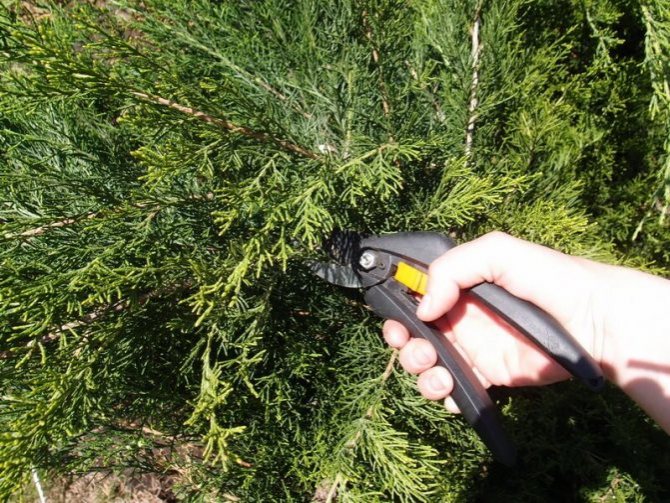

Pruning guidelines
What should be observed when pruning thuja in the autumn? Pruning this evergreen is a very delicate matter. The haircut should be useful for the ephedra, so it must be done carefully. First of all, cut off sick, dried out and spoiled by pests and the sun twigs. The bush is thinned out, that is, part of the shoots is removed inside the crown. Thanks to this manipulation, the ventilation of the tree is significantly improved.Thinning will also reduce parasite infestations.
To achieve the growth of thuja in width, part of the top is removed from the plant. The spherical shape is given to the tree by removing the shoots protruding from the crown. The selected form of the shrub is supported by cutting off some of the last year's branches. It must be remembered that the thuja cannot be cut off too much, otherwise it may lose its decorative appeal. If the pruning did not work out in the autumn, then the procedure is transferred and performed in the spring or summer. With a few scraps, the shrub gets rid of dead and unnecessary branches. Popular haircut patterns for thuja are spherical, topiary and spiral.
Thuja covers. How to properly prepare thuja for winter?
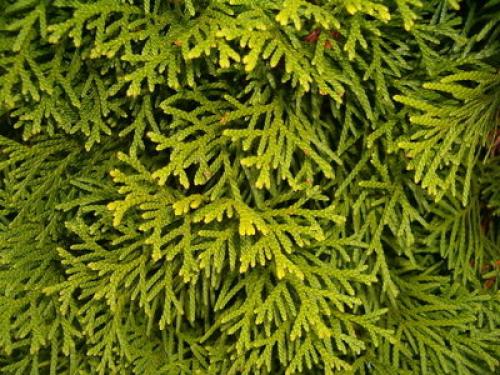

Thuja is often found in household plots, since it complements the territory well and performs decorative functions. The crown of a decorative ephedra can be easily formed, and the plant itself is unpretentious. Despite all the advantages, ephedra must be prepared correctly for the winter period of time, because the branches of the plant are fragile and cannot stand sunlight, which is especially bright in spring.
Preparing for winter
Thuja has good frost-resistant properties and therefore winters well even in severe Siberian frosts. However, wintering the plant can be challenging as the coniferous twigs are fragile and can break under the snow cover, and the bright spring sun can burn the tree. When preparing plants for winter, attention should be paid to young trees, since they are more exposed to the influence of an unfavorable environment.
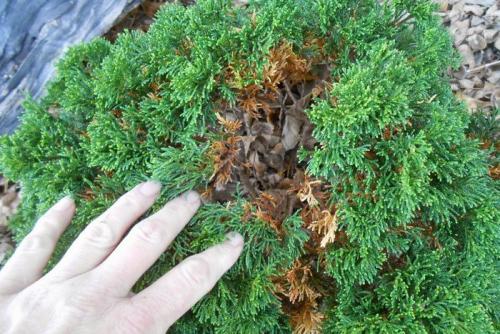

To protect the decorative ephedra, gardeners completely wrap the plants, turning it into a "cocoon". If the plant is not properly covered, it will begin to turn yellow by spring.
Such a shelter is necessary for thuja, because it allows you to protect small branches from mechanical damage, especially young trees planted in the fall should be covered in this way, since they do not have time to take root completely before the beginning of winter.
Autumn pruning
Depending on the variety, when pruning thuja, various shapes can be formed that can improve the appearance of the crop. Before the onset of winter, the plants are additionally pruned, which is no longer decorative, but sanitary. Since it is in the fall that you can remove excess twigs that were damaged or dried out in the summer.
The period of pruning ephedra is determined by the weather conditions for growing the plant. Experienced gardeners recommend pruning the thuja one month before winter so that the plant has time to recover from the harsh conditions. The most favorable period for pruning is dry and not sunny weather with a temperature of +5 degrees.
Tips for pruning ephedra:
- dry, diseased and damaged branches must be removed first;
- after which they begin to thin out the plant, since small branches worsen air permeability and increase the likelihood of needles drying out;
- depending on the shape of the thuja, it is necessary to adjust its upper part, since over the summer the tree can stretch out;
- the latter remove dark shoots that spoil the appearance of the plant and are last year.
After removing all excess branches, the tree is left alone until spring pruning, which already allows you to give the shape of a thuja.
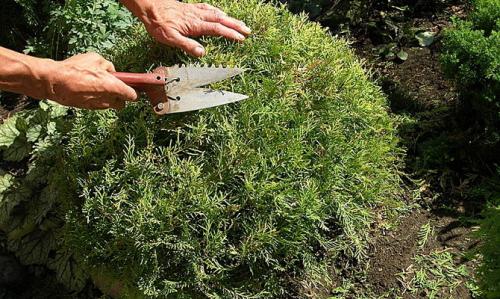

Shelter
You can not cover the thuja for the winter with any materials, since they must transmit light and air well, and not collect condensation, otherwise the needles of the plant will rot. The most suitable material should be light in color, otherwise the ephedra will not receive the necessary lighting. Suitable materials for shelter:
- a fabric that is good for using burlap or gauze. A kind of covers for coniferous wood are made of the material;
- kraft paper;
- other garden materials.
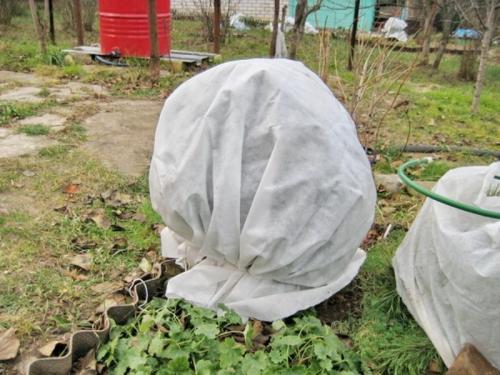

The latter material is not the most suitable because it does not allow air to pass through well.In case of extreme necessity of its use, it is necessary to choose non-woven garden materials with the lowest density and organize additional ventilation near the crop trunk. If you don't have the time and desire to make this cover yourself, you can purchase it at any garden store.
It is necessary to cover trees after the first snow falls, because it is during this period that stable weather begins to establish with a slight frost. In other cases, overheating or hypothermia of the thuja is possible.
In Central Russia, the shelter of conifers occurs at the beginning of November, and in frosty regions at an earlier period.
In addition to covering the crown, it is necessary to protect the root system of the culture. Roots are warmed by mulching. It is recommended to use compost, peat and humus as mulch as they generate heat. Ideally, the mulching layer reaches 20 cm. In regions with harsh climatic conditions, which are located mainly in Siberia and the Urals, it is recommended to additionally use spruce branches to warm the root system. In the spring, the spruce branches are harvested, and the mulch layer remains as fertilizer.
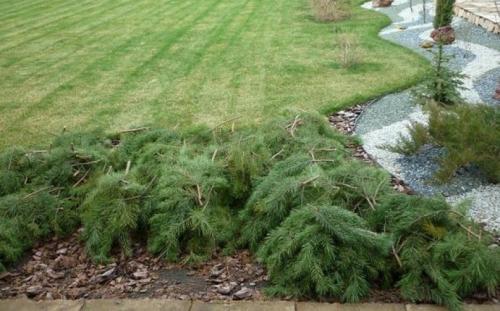

The main mistakes of gardeners
Novice gardeners quite often make mistakes when caring for thuja in the autumn. Such errors relate mainly to pruning, feeding and covering the crown. For example, if you cut the crown of an ephedra in bright sun, the needles will begin to darken. If a young plant begins to turn yellow in the spring, it means that a sunburn has occurred, etc. All negative tendencies are formed due to improper care in the fall.
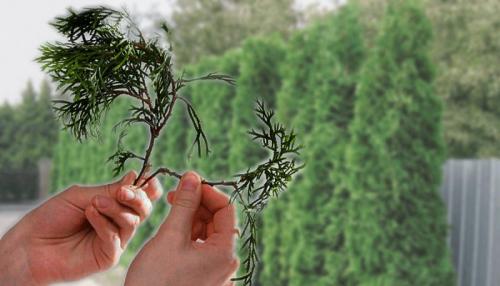

Preparing a coniferous tree before winter is not difficult and even a beginner gardener can handle it, since the main care is watering, pruning, feeding, mulching and shelter.
There are even more articles in our classmates group.
Snow protection options
When choosing a shelter for evergreen plantations, you need to give preference to breathable materials, under which condensation does not form in case of warming:
- burlap - convenient to use for small young trees;
- spruce or pine spruce branches - suitable for low-growing exotic species;
- thick kraft paper is ideal for insulating columnar trees such as cypress, young fir, thuja or berry yew;
- woven polypropylene fabric.
You should not use polyethylene or non-woven materials that are now popular in gardening for insulation: lutrasil, spunbond. They are designed to trap heat inside, but they do not release it outside, as a result of which the plants are weighed out during the winter. In addition, these materials do not save from severe frosts.
Protection for medium-sized shrubs
To shelter coniferous bushes that have not yet reached 3 years of age for the winter, we first bend the branches to the trunk of the tree. To do this, we take a string, preferably green or the color of the trunk, and, without pressing hard, lightly wrap it with a cord so that the legs of the trunks do not stick out. After that, we take a non-woven material or spunbond, and determine the size of the future bag. Then we fix the seam with a stapler.
To date, manufacturers offer ready-made agrotex bags of various sizes. Spruce and pine need autumn shelter only in the first year of life.
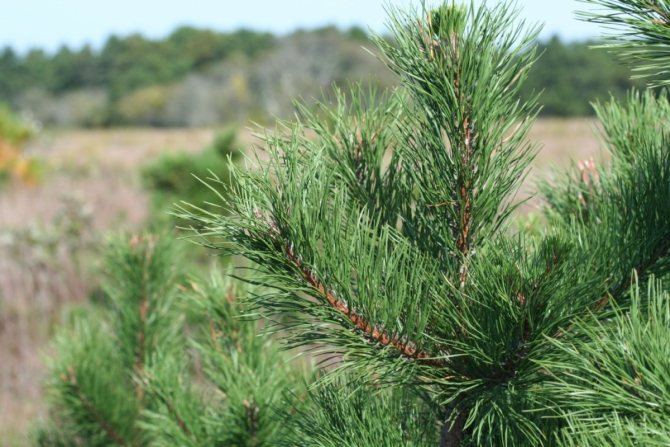

How to cover shrubs and young trees of medium height, so as not to damage the crown and preserve the integrity of the culture as much as possible? For this, a wooden frame is constructed from bars of medium thickness.
Advice! "You can make a frame out of an elastic plastic mesh, which is very convenient because of its flexibility."
It is better not to install an iron or wire frame, as the metal conducts cold and can cause frostbite on the branches.
After preparing the walls of the frame, we wrap it with a covering material. It is better not to use polyethylene for these purposes, as it collects moisture.The moisture accumulated under the film freezes during the winter cold and does not contribute to thermal insulation or leads to decay and the appearance of mold. In addition, polyethylene may not withstand low temperatures and burst, allowing snow and cold wind to penetrate. To protect coniferous plantations for the winter, it is better to use:
Any of the listed materials, except for kraft paper, can be stapled to a wooden frame. You can wrap the insulation around the mesh by joining the ends into a single seam.
Any agrofiber should be of medium thickness for air intake (sometimes they leave a small gap or do not fix the top), but not tear from strong gusts of wind. After winter, you need to remove shelters in early April or late March, when it gets warmer and sap flow begins. Moderate snow melting and an air temperature close to 0 ° C will tell you when to open the insulation.
If your pets have reached the age of 4, and you did not cover them, but only pulled them with twine, then we do the following shenanigans. At the end of February, on the south side of the garden, we install an awning made of any available covering material. Our goal is to create a shade curtain so that conifers do not get sunburn from the blinding sun.
Spruce Konik at home
The story of my Koniki's life began on New Year's holidays, when I received a tiny coniferous tree as a gift. He was not even visible under the shell of glittering tinsel. For greater beauty, the needles were covered with artificial snow. At first I kept a pot of Konika at home. Of course, all the jewelry was removed from her, and the needles were carefully about. It was hard for the Christmas tree: the roots suffered in a cramped flower pot with a coconut fiber substrate. Part of the needles fell off in the dry warm air. I had to make a transfer into a larger pot with normal soil and move Konika to a glazed loggia. There the Christmas tree lived in a flower pot almost until May. During this time, she did not grow up, but she became prettier and stronger.
Strengthening new plantings
Conifers collect large amounts of snow on their branches. And if winter also pleases us with abundant snowfall, then a sticky snow mass can form on them. Such a weight is sometimes too heavy, especially for seedlings that did not have time to take root. Therefore, in order to avoid their fall and prevent root breakage, it is better to fix the plants with stretch marks. This material is useful for owners of blue spruce trees.
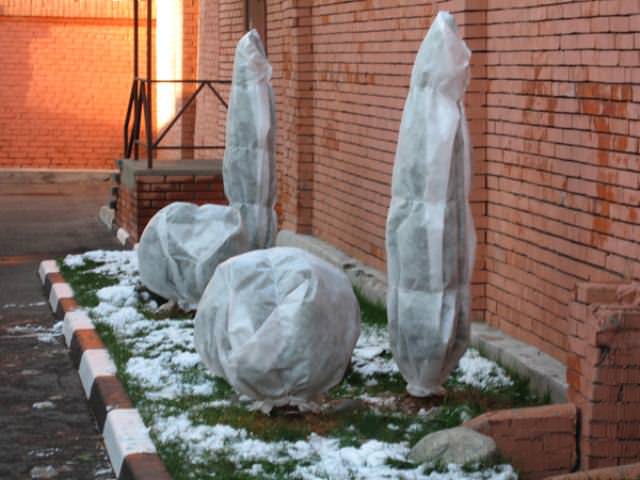

Dangers for ephedra in the cold season
Young plantations, which are not yet 3 years old, become especially vulnerable to cold weather. The main enemies for them are:
- cold frosty wind;
- winter thaws accompanied by snowfalls;
- sun rays that are reflected from the snow.
A strong winter wind dries up the branches, which, when frozen, become fragile and brittle. If possible, it is recommended to plant conifers along buildings that will serve as a screen for plantings from the cold wind.
Winter thaws lead to a large amount of snow adhering to the branches and the formation of ice. Branches weakened by the cold winter wind often break under the weight of ice.
The needles of young trees can get severe burns at the end of winter, when the bright sun appears, the rays of which, reflecting from the snow, harm the coniferous plantations.
Shelter from snow and ice
To protect the lovingly planted yew, cypress or thuja, it is necessary to cover conifers before the winter cold, especially at a young age. They are wrapped in non-woven fabrics and secured with a stapler or special caps are put on them, which are commercially available and attached to rods stuck in the ground.
Sun protection
To protect a young tree uncovered for the winter from spring rays, it is required to install sun protection on the south side before heavy snow melting. An awning is made from any available material:
- old sheets sewn together;
- old curtains;
- covering material.
If you do not want to put up an awning, you can cover the conifers with a cloth on top and fix them.
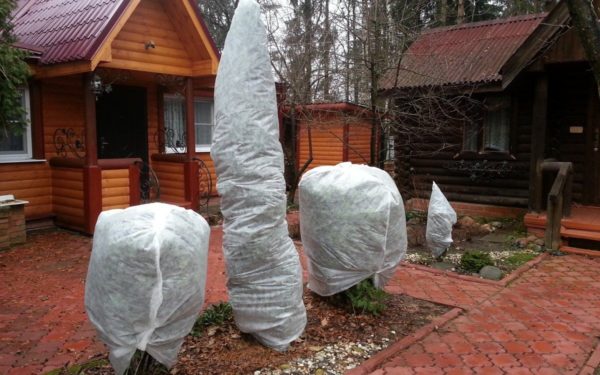

Caring for conifers before hiding
Before starting to shelter conifers for the winter, it is necessary to carry out a number of additional measures that will contribute to the preservation of young plantings. In autumn they produce:
- watering to a depth of 50-60 cm within the radius of the root system (in case of heavy rains, the procedure is canceled);
- the introduction of vermicompost, compost, dolomite flour will give the plants the strength to overwinter;
- mulching with needles, spruce branches, sawdust, peat (hay is not recommended because of the possibility of rodents) contributes to the preservation of the root system;
Description and characteristics of larch Stiff Viper on a trunk
Stiff Vipper is a coniferous tree with creeping shoots. Although the traditional Kempfer in its natural environment can reach 35 m in height, the described form is short: its height does not exceed 2 m, and its width is no more than 1 meter.
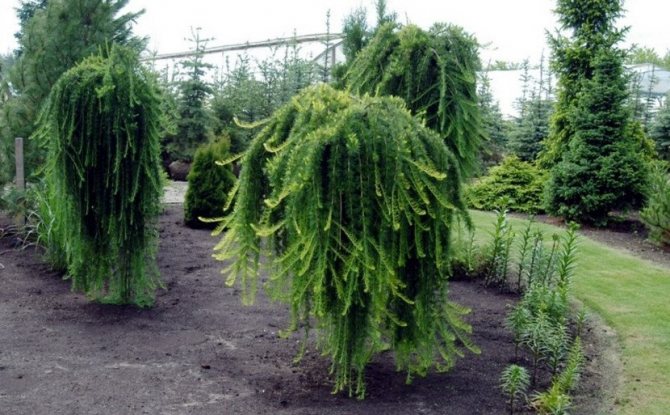

The tree is rather fast growing - up to 30–35 cm per year. A plant on a stem can add to growth after grafting no more than 20-25 cm, shoots - up to 50 cm, then they begin to grow down, reach the ground and spread along it.
Did you know? Kempfer's fine-scaled larch was originally endemic to the island of Honshu.
— that is why the species began to be called Japanese. Later, the tree was naturalized in Sakhalin.
The shape of the crown is weeping. The color of the needles dropped for the winter is bright green with a bluish tint. In autumn, the color changes, acquiring a golden hue. The soft and flexible needles resembling foliage can be up to 5 cm long. The bark is brown with a pronounced orange tint.
Cones are spherical, 2–2.5 cm long. Women are lilac, men are olive shade with thin leathery scales, slightly curved outward, like rose petals. They keep on branches for three seasons.
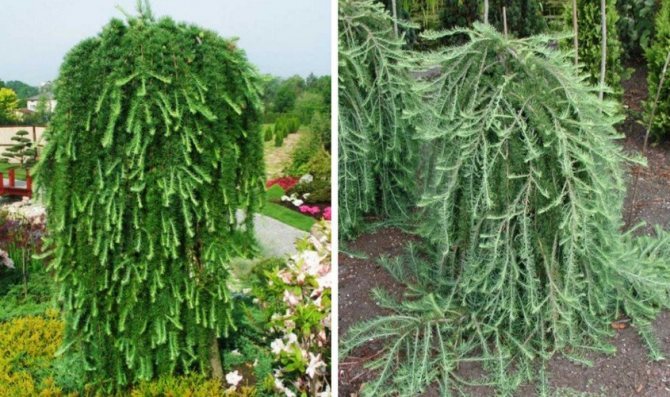

Top dressing for blue spruce
There is a lot of controversy about this, and in order to achieve the truth, we specially conducted long conversations with summer residents and owners of some nurseries, and even read forums where the owners of Christmas trees share their opinions and experiences.
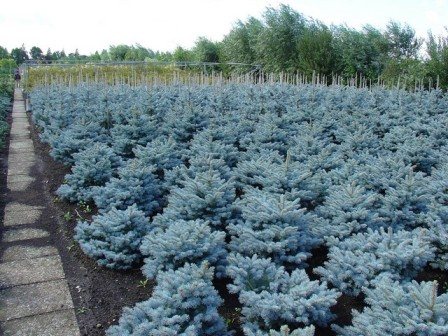

Even in the industrial cultivation of blue spruce, top dressing is applied neatly and in small portions.
As it turned out, many generally refuse to feed the plant, although they admit that the plant practically does not grow until 5-7 years old. You can, of course, use growth stimulants and some fertilizers, but then you can achieve the effect of a real forest tree in your country house, and this is certainly not interesting to anyone.
After 5-7 years of cultivation, blue spruce is gradually growing, and in the next few years it freely gains 30-40 cm, and sometimes 50-70 cm per year. If you do not overfeed the tree, then literally within a few years the growth of the tree stops, and a pretty tree flaunts on the site, which is truly decorative!
There is also an opinion that top dressing is harmful to the spruce, and because of them, a certain type of mutation can be observed, when, for example, side branches turn into stem, and then the tree does not grow up, but to the side. It is also worth noting that it is not recommended to apply top dressing in the fall, otherwise the tree may not survive the winter. If you use fertilizers, then this should be done in spring and early summer, in small portions!
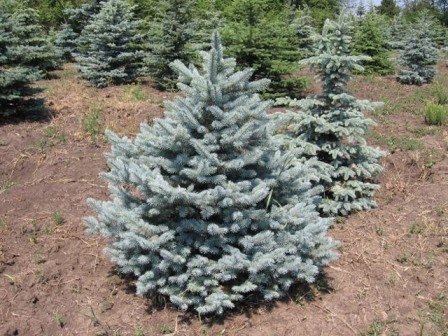

There are many controversies about the need for fertilization under the spruce.
It is strictly forbidden to apply nitrogen fertilizers and manure, which do not have a positive effect on the plant. But you can use universal fertilizers in small quantities.
What are the difficulties when growing
If you did everything right and at the right time, growing Stiff Viper larch should not cause you any significant problems. Some difficulties may arise when performing the vaccination, but this is not the main procedure necessary for the normal functioning of the plant - you can do without it.
Important! Trees should not be planted too densely - excessive moisture can cause the development of fungal diseases.
Care should be taken to create a shelter for the winter for a young plant. Until Kempfer is strong enough, frost can be dangerous for her.Another significant point to which you need to pay attention is the organization of proper watering.
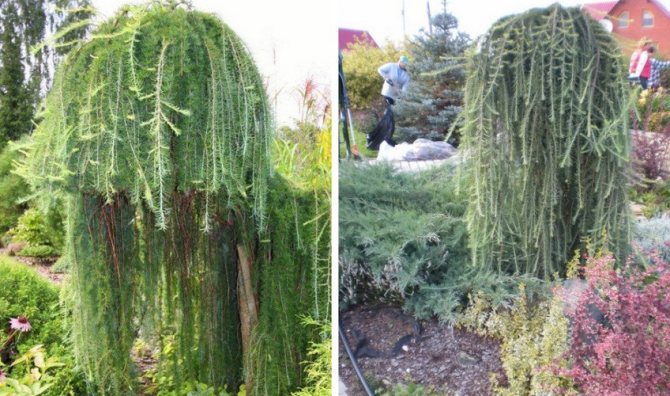

The Stiff Viper thin-flaked larch can decorate any garden or home plot.
As already mentioned, the tree does not like swampy soil and its waterlogging, as well as excessively dry air. The tree looks great and goes well with many conifers and deciduous plants in a wide variety of compositions. And when creating the conditions described above, you should not have any difficulties in growing Kempfera.
Shelter of conifers
November and early December are suitable for sheltering conifers for the winter.
Winter protection for shrubs of medium height
In the Moscow region, the shelter of conifers for the winter is somewhat different due to their size. To close medium-sized plants from the wind and sun, most often they make a wooden frame, which is wrapped with a covering material and fixed with staples with a stapler.
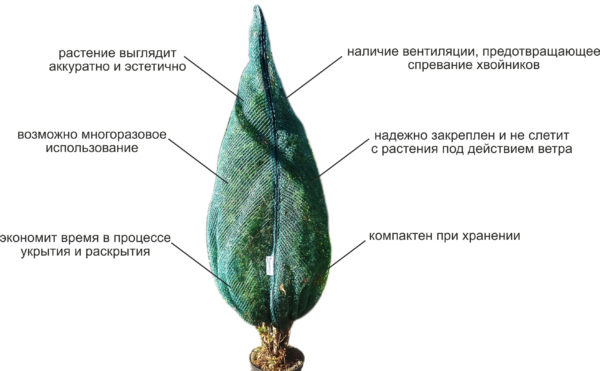

Winter protection for low-growing shrubs
For creeping species of juniper and other young conifers, it is not difficult to build a shelter for the winter. One has only to stock up on spruce branches and cover the young plantings in the form of a cone.
Shelter of pine and spruce
Pine and tree need shelter only in the first year of planting. In order to insulate a young tree, it is necessary to do the following manipulations:
- strengthen the ephedra by attaching it to the support;
- mulch the ground around the trunk and close it with spruce branches;
- wrap the crowns and branches with covering material.
If the tree does not grow stronger in the second year of life, shelter should not be neglected.
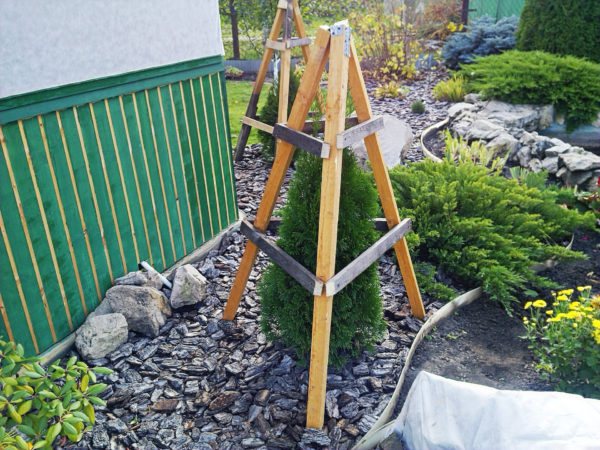

Larch shelter
Larch is not afraid of the cold, and the need for its shelter disappears 2.3 years after planting. In places with heavy snowfall, a tripod is installed above the plant. From above it is wrapped with suitable material: lutrasil, burlap, old sheets, etc.
Juniper shelter
This type of conifers is suitable for planting in summer cottages by novice summer residents. For the first 3-4 years, the juniper for the winter must be protected from burns, it also needs insulation. Juniper branches are very sensitive to sunlight. First thing:
- Tie the branches to the trunk with twine.
- Wrap the plant with covering material or garden bandage.
- Several metal pins are stuck around the tree, on which a metal mesh is put on.
Cypress shelter
It is recommended to plant kaparisovik in places that are not blown by winds, and on the south side it needs shading. For this, conifers are sheltered for the winter. Most often they are tied with cloth.
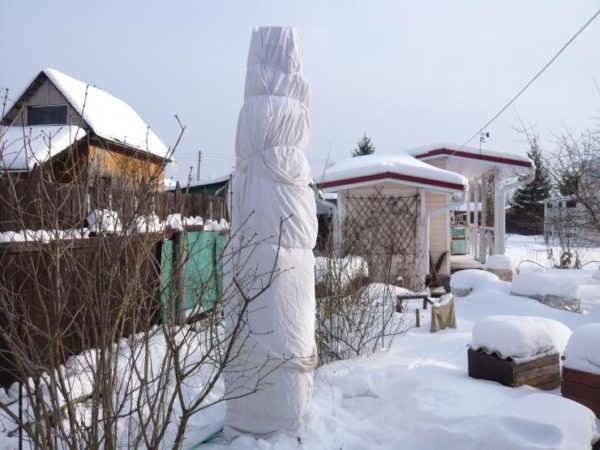

Thuja shelter
Thuja is a shade-tolerant plant, so it feels uncomfortable in the sun. On sunny frosty days, it can burn on the south side. It is recommended to wrap with a light covering material before snow melting. Tall plants are wrapped in twine.
Yew shelter
Shelter of conifers for the winter, such as the yew, is a prerequisite for its survival. In the wild, yew grows in southern countries, so it needs a winter shelter. It is recommended to tie the branches to the trunk with twine and protect them from the cold with a white cover, leaving a small hole for ventilation.
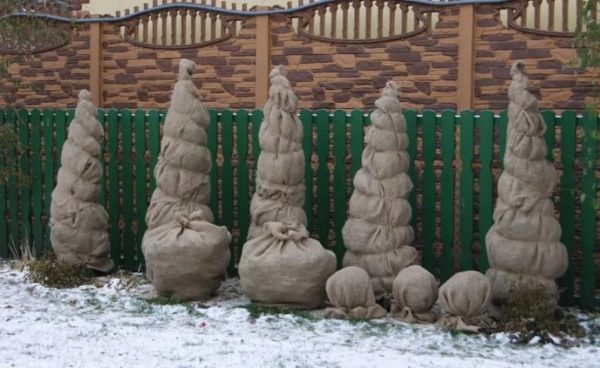

Fir shelter
Siberia is the homeland of fir, and, as a winter-hardy plant, it needs shelter only at a young age. They cover it in the idea of a house with twigs or put on a cover, pouring mulch under the tree to preserve the roots.
In the spring, do not rush to remove the shelter. This should be done on a cloudy day, when the temperature rises to about +10 degrees. To help plants get away from winter frosts completely, they can simply be sprayed with warm water with a growth stimulator.
If you carry out all the recommended procedures on time, the ephedra will easily endure the winter. It is always easier to properly prepare plants for wintering than to take measures to resuscitate the affected ephedra in the spring.
The coniferous plants planted this year do not have time to develop powerful rhizomes and get stronger for survival in harsh winter conditions during the season. Young plantings need protection, created in various ways using factory or homemade designs.
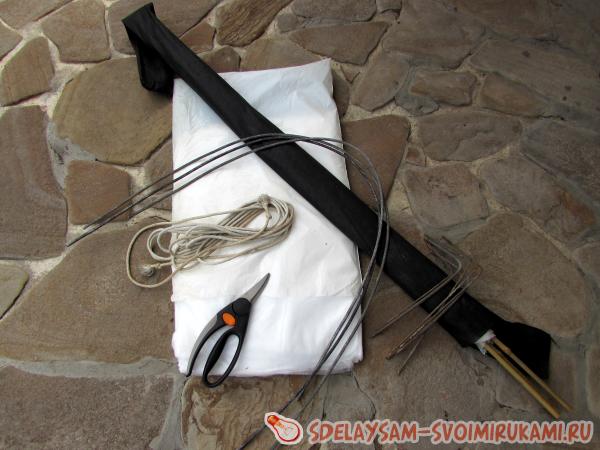

The optimal time for sheltering plants is dry weather, established with the arrival of stable cold weather. Protective materials are recommended to be placed on frames that ensure the integrity of the branches and optimal ventilation.
We purchase ready-made shelters.
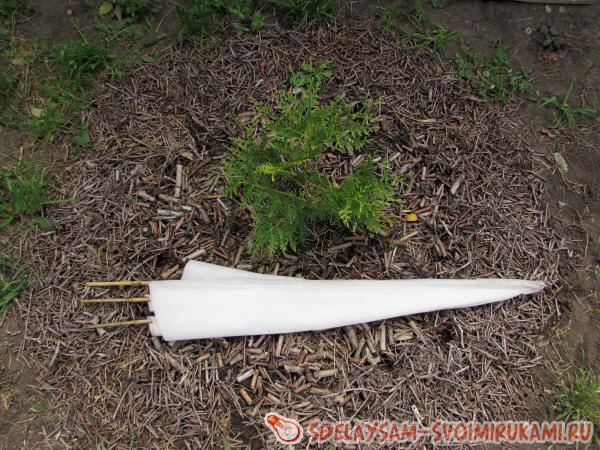

Purchased designs are ready-made kits that are easy to install and do not require additional devices. Among the many options, you can always pick up shelters that are suitable in shape and size.
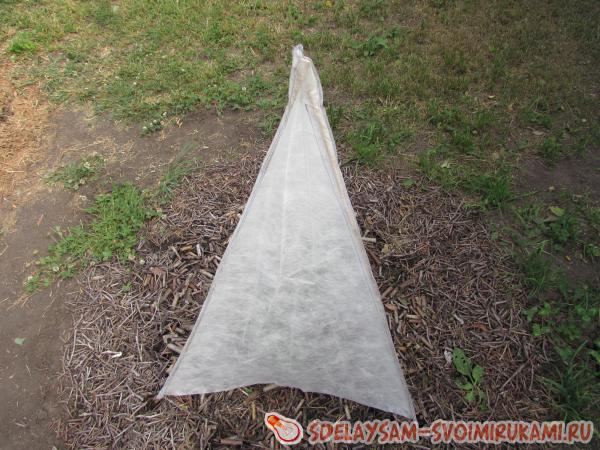

The frames of these products are made of polymer or metal tubes, bamboo rods or fine mesh. As a protective material, non-woven fabrics are used that allow air to pass through and maintain a dry atmosphere inside the shelter, for example, "Snapbond" or "Agrospan".

